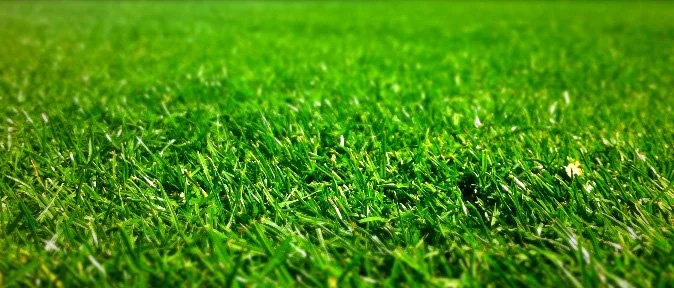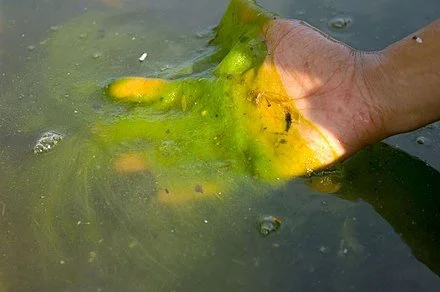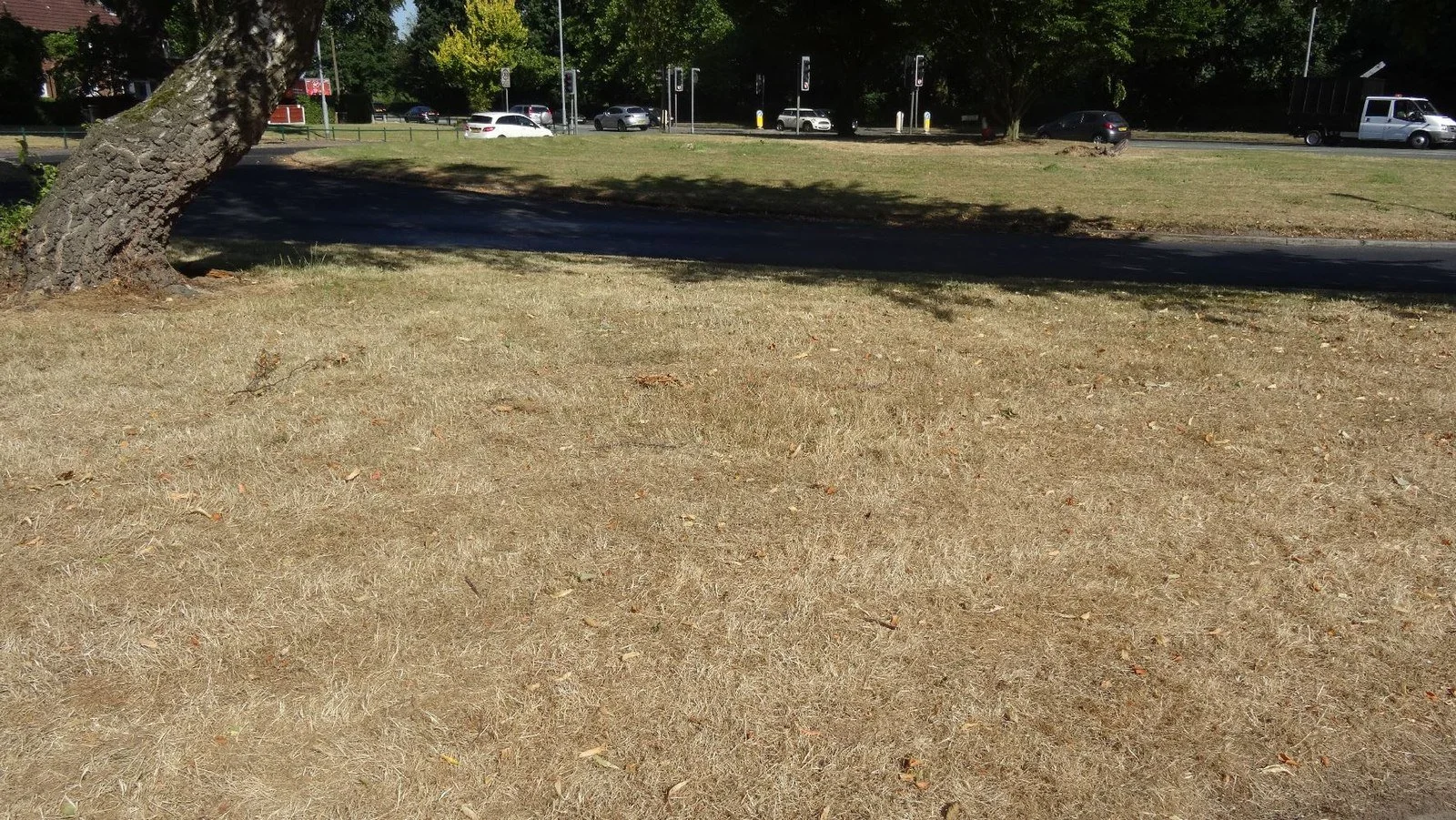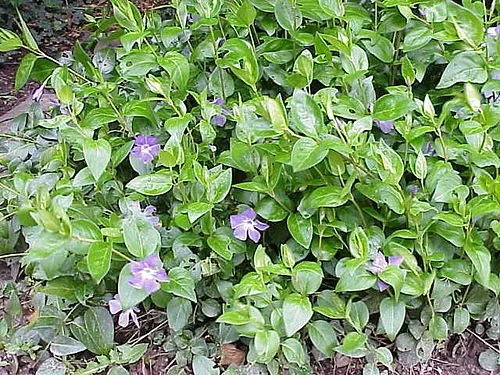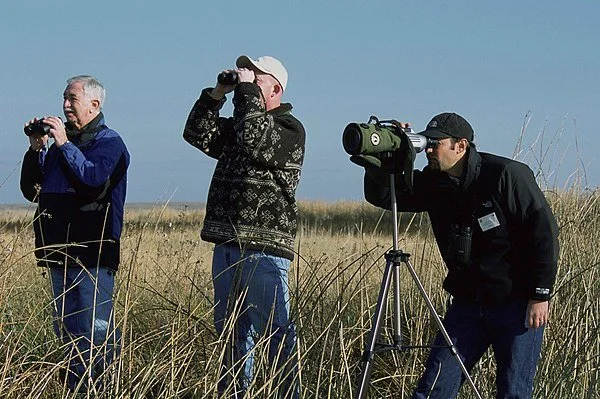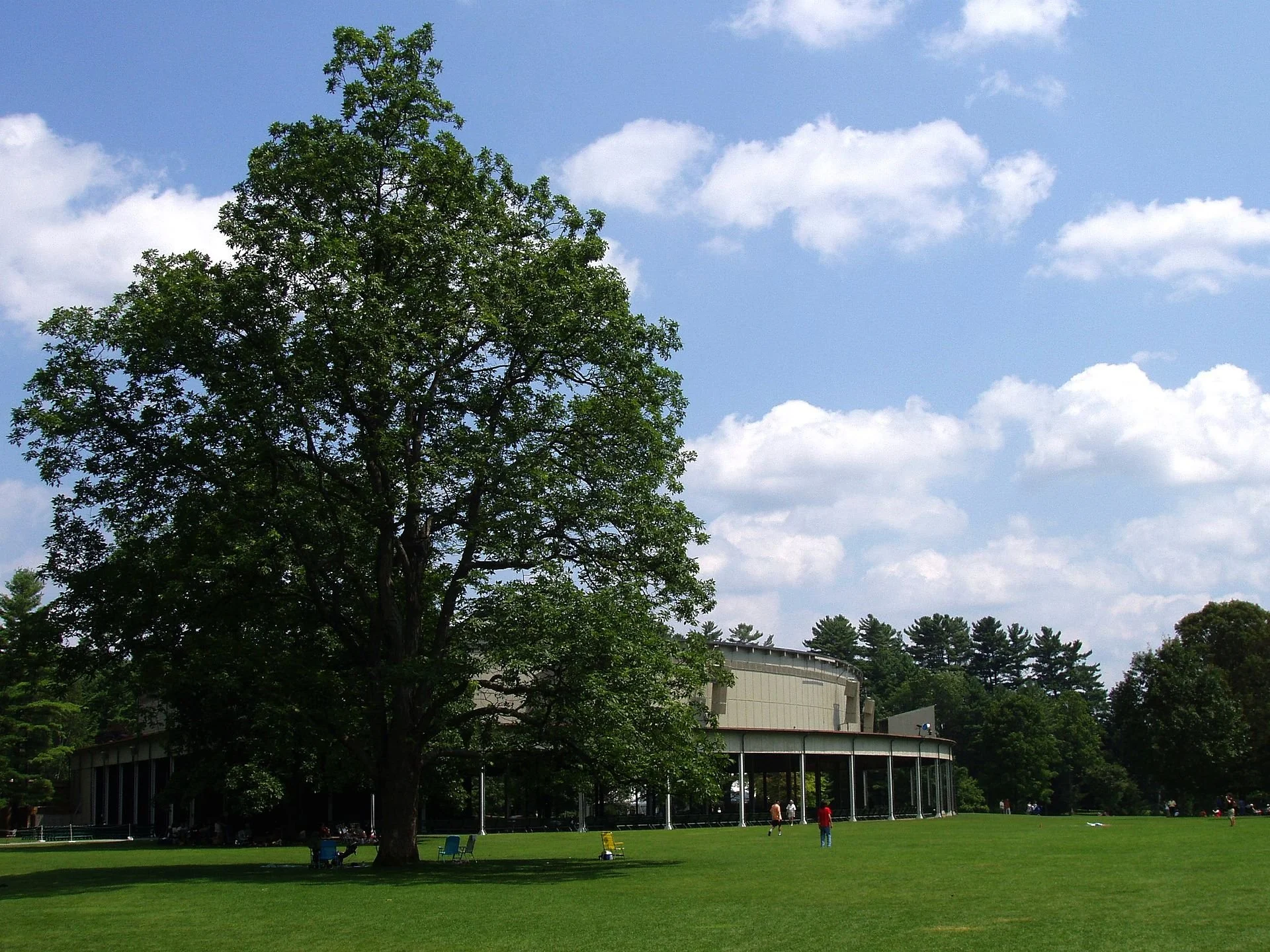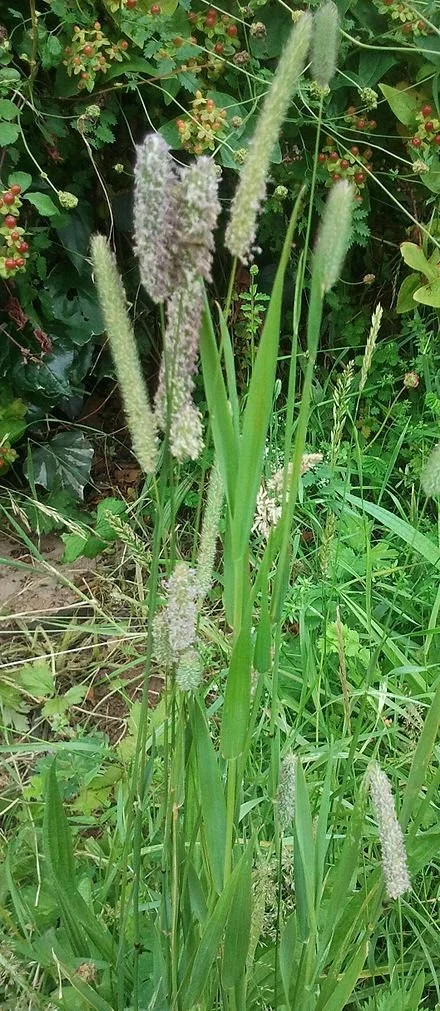Frank Carini: Lawn fertilizers and pesticides threaten public health and environment
A newly seeded, chemically fertilized and mowed lawn.
— Photo by Animaldetector
An example of eutrophication caused by fertilizer runoff. These nutrients cause the excessive growth of algae, which can block light and air exchange. The algae eventually are broken down by bacteria, causing anoxic conditions and "dead zones".
Text from article by Frank Carini in ecoRI News
“While this winter in southern New England has mostly felt more like a three-month extension of fall, spring officially arrives in a few weeks and that means the lawn-care industry’s push to douse lawns with chemicals is in full bloom.
“Industry professionals and homeowners have been dumping pesticides, herbicides, and fertilizers on lawns for generations, all in hopes of creating lush, green carpets of neighborhood envy. This heavy reliance on chemicals has instead turned residential soil into de facto dumping grounds for lawn-care poisons that threaten public health and the environment….
“When these monolithic landscapes are then flooded with mass-marketed poisons and nutrients, they become bad for human and pet health, pollute local waters, deter wildlife, and degrade the environment.’’
To read the whole article, please hit this link.
Lawns are killers
Groundcover of Vinca major. Better this than…
….this
Adapted from Robert Whitcomb’s “Digital Diary,’’ in GoLocal24.com
Looking at New England’s parched lawns in the past few weeks reminded me of the environmental damage done by America’s post-World War II obsession with lawns, which has a lot to do with the explosion of suburban growth, subsidized by federal, state and local policies. Showing off your lawn has been a competitive sport.
Think of all that water and the toxic fertilizers, pesticides and herbicides dumped on lawns to try to defy the cycles of nature! (Nature in New England wants woods, not lawns.) Of course, the chemicals in the fertilizers and pesticides end up in ground water, streams, ponds and the ocean. Then there are the heavily polluting, gasoline-fueled lawn mowers.
Still, it’s easy to see the attractions of lawns: soothing green open space around houses, to look at and lie, sit and play on.
Anyway, it’s been gratifying to see more people replacing all or part of their lawns with various ground covers that require much less water and little or no chemicals. They stay green with little care. And you don’t have to mow them, just occasionally do some clipping, depending on the height of the plants. And birds much prefer ground cover, which provide much more food than lawns as well as shelter for some species. Okay, I know that some people don’t like squirrels, rabbits and chipmunks….
But Americans have been indoctrinated to have lawns. It may take years of further environmental damage amidst climate change to get many more of us to sharply reduce the space we devote to them.
You might enjoy this video.
New England has long had many birders – in the countryside, the suburbs and even cities. Indeed, it may be the birding center of America. The hobby pays off for the rest of us not only as a fun force for identifying and photographing birds, many of which are beautiful, but also, in the case of endangered species, helping to save them through publicity. Birders also monitor the local conditions of nature in general. They’re watchmen (or is it watchpersons?) of the environment as they wander outside with their binoculars and notebooks.
When I think of birds I always remember a talk at my high school, in Connecticut, by Roger Tory Peterson, the famed American naturalist, ornithologist, illustrator and educator, about the centrality of birds in nature, and around the same time reading Silent Spring (silent because of the disappearance of bird song in many places) by Rachel Carson, about how pesticides were killing many creatures. The book helped lead to the creation of the EPA and the Endangered Species Act.
It seems hard to believe now that we blithely sprayed vast areas with DDT, dumped cancer-causing chemicals in the ground and water and used lead in most gasoline and house paint. (Yes, lead paint was popular because it lasted a long time on walls.)
Roger Tory Peterson at work, probably in or near the Connecticut River Valley.
Cynthia Drummond:New England lawns are changing with the times
Tanglewood Music Shed and lawn, in Lenox, Mass. Music lovers sit and recline on this famous lawn while listening to summer concerts of the Boston Symphony Orchestra
— Photo by Daderot
From ecoRI News (ecori.org)
RICHMOND, R.I. — Love them or hate them, lawns aren’t going to disappear from the New England landscape anytime soon. Caring for those islands of green can be as casual as an occasional mowing, or as involved as season-long programs that include watering, adding nutrients and eliminating weeds and insect pests.
University of Rhode Island Professor Bridget Ruemmele teaches several turf grass courses, including management and irrigation technology. Her research focus is turf grass improvement.
In drought-prone states such as Texas, where Ruemmele worked before coming to Rhode Island, many municipalities require homeowners to use xeriscaping, landscapes composed of plants that need much less water than traditional lawns.
Ruemmele said lawns remain popular in Rhode Island because they provide areas for recreation, and they are less likely to harbor ticks.
“One of the advantages, of course, of having at least some lawn near your buildings is, you don’t have to worry as much about deer ticks [which spread Lyme disease]. That’s the big issue,” she said.
Recent hot, dry summers have resulted in watering restrictions in many towns, leaving lawns brown and stressed and prompting calls to URI from homeowners asking what they can do to counteract the effects of drought.
“We tend to have fairly regular rainfalls, but when there are droughts, the years we have droughts are when people all of a sudden go ‘Oh, maybe I should be concerned about it,’ and that’s when we get more calls and requests for information,” Ruemmele said.
Some homeowners are taking a more radical approach and reducing the sizes of their lawns. Young people may not be as interested in lawn maintenance and older couples who no longer have children at home don’t need the recreation space.
“As people seem to be aging, they’re more interested in not having as big of a lawn area,” Ruemmele said. “Some of these people who are reducing their lawn are spending hours and hours every week maintaining the alternative plants they put in, so it very much depends upon what kind of plants you decide to put in whether or not you’re going to be saving time, because if you’ve got a lawn, essentially, mow it once a week.”
The most widely used turf grass species, Kentucky blue grass, is not considered to be drought-tolerant, although Ruemmele said the original blue grasses were much tougher than the varieties sold today.
“For years, people associated it with high maintenance and that’s because, back when we were less concerned about the environment, breeders developed grasses that responded to increased irrigation and increased fertility, whereas the more common types of Kentucky blue grasses…they are the ones that were adapted to whatever the environment threw at them, so they were able to tolerate periods of stress and that’s a major emphasis that turf breeders have gone back to.”
With nutrient runoff, much of it from fertilizers, polluting coastal waters, Ruemmele said municipalities are beginning to restrict outdoor water use as well as the types of fertilizers that homeowners can apply to their lawns.
“The emphasis is on, especially, not automatically applying a fertilizer, emphasizing that you’re going to be getting a test of your [turf] fertility every couple of years and then only applying the fertilizer that’s recommended,” she said.
As an example, Ruemmele cited the intensively marketed “four step” program, in which most of the steps are usually unnecessary.
“What I think about the four-step program, is that if you don’t have grubs, you don’t need that stuff, and if you keep a nice, healthy, dense turf, that’s going to be eliminating most of any perceived weed problems that you might have, and you can eliminate that step. And so basically, the step that has fertilizer only is about the only one you really need,” she said.
Dana Millar, of West Kingston, is known for his organic lawn care service, although his company, Dana Designs, also provides conventional services to homeowners who request them. Most of Millar’s clients still ask for conventional services, but an increasing number of customers, about 65 at last count, prefer organic methods.
Organic lawn care is based on the premise that healthy turf grass requires healthy soil, so rather than applying chemicals to the grass, Millar uses a bottom-up approach, building nutrients in the soil that support the grass.
“Top down, you’re applying materials and products over the top,” he said. “Organically, you are encouraging the health of the soil, so the soil feeds the plant.”
Millar believes that organically grown grass is not only stronger, but also more resistant to environmental stressors.
“Over the period of the last two years, we’ve had greater drought than anybody had in memory and in this past year, there was more rain than anybody had in memory,” he said. “Each one of those climate-driven events stressed lawns in different ways. My organic lawns were more resilient, so in the drought, they went into drought stress later and came out of drought stress more quickly, and lots of times, didn’t need much repair, whereas lawns that may have been conventional had a harder time and they weren’t able to fend off insects. They weren’t able to fend off diseases and their recovery, in some cases, wasn’t complete. The turf was damaged and had to be completely restored.”
One of Millar’s early mentors was Earth Care Farm founder Mike Merner, a believer in the benefits of compost and the importance of nurturing the microorganisms that live in soil and make it productive.
Millar always begins an organic program with testing and amending the soil, which can be a complicated process.
“We need to know what the state of the soil is, so every organic program begins with a soil test, and we ask more from a soil test than the conventional test, because we want to know organic matter, we want to know cation exchange capacity, we want to know not only the soil pH, but its resistance to change. …This determines the type and amount of amendments that we might need to improve soil and gives us a baseline for expectations and a budget over a period of time,” he said.
While lawn care products have traditionally been marketed to men, Millar said many of the clients of his organic service are women who have taken over the responsibility of lawn maintenance from their male partners.
“I have lots of women clients who are at a point in their lives where they have the discretionary income and the authority in their households to make decisions which are usually the males,’ ” he said. “‘How are we going to treat our lawn? Why are we going to do this? I want a garden, I want to feel safe and I want my grandchildren to have the freedom to enjoy our lawn.’”
Cynthia Drummond is an ecoRI News contributor.
Timothy grass, probably named after Timothy Hanson, an American farmer and agriculturalist said to have introduced it from New England to the South in the early 18th Century. European settlers introduced it into New England in the late 1600s and by 1711 it had become known as Herd’s grass, after John Herd, a Maine farmer who began to cultivate it.
Lose the lawns
Drought-stricken California is starting to make developers reduce the area devoted to lawns, which are huge water-guzzlers. You'd think from looking at Southern California's heavily lawned landscape that it is as wet as New England rather than a desert made green by water from hundreds of miles away in the High Sierra. Lawns, even in usually damp New England, are huge wasters of water, and a major contributor of pollution from the fertilizers and pesticides that folks dump on them, often to excess.
Ground cover or just trees are a much better use of the land, though I still appreciate the beauty of a very green lawn. I have fond memories of lying on them on hot, pre-air-conditioned nights watching the fireflies. But we give lawns far too much space.
I wish that my parents had planted over their lawns on the Massachusetts coast with something that didn't require my spending many hours a month cutting them -- my earliest steady "summer job.''
Back then, in the '50s and early '60s, we never worried about using too much water or about pouring on the (pre-Silent Spring) pesticides and fertilizer.
-- Robert Whitcomb



